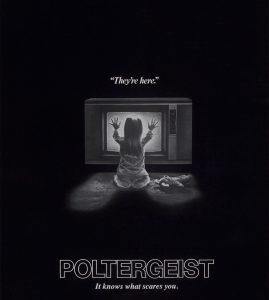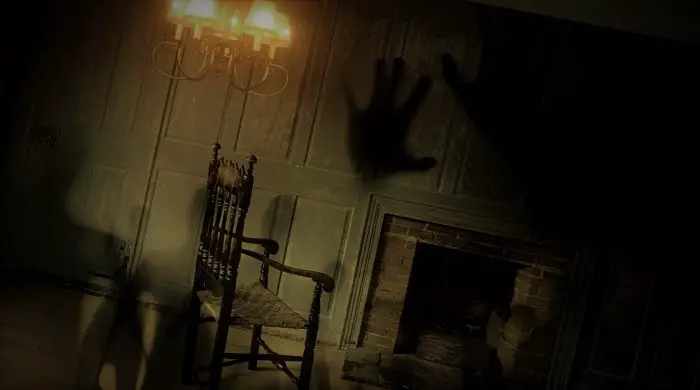Share the Lore!
By: Alex Postrado
Stories about ghosts and hauntings have long fascinated mankind.
And it seems like, regardless of where you are in this world or what era you live in, these paranormal encounters will always follow you.
Unsurprisingly, the horror genre eventually picked up how these supernatural phenomena could rake up crowds — preying on people’s fear of incorporeal beings and the occult.
This is why we now have, what we call, paranormal horror.
A subgenre that is — arguably — most dominated by entities called poltergeists.
These are the spirits responsible for the hair-raising activities from — good guess — the Paranormal Activity franchise, and of course, the terror from the trilogy fittingly named after the ghost, itself, Poltergeist.
A class of malevolent ghosts, known to cause physical disturbances, and are said to be capable of hurting people.
Here is the bizarre history, as well as popular claims, about poltergeists.
What is a Poltergeist?
Ghosts are scary — at least for most people.
And we get it. After all, the idea of having someone else around you — especially, when that someone is an entity you can’t see — could be really creepy.
But do you know what’s twice as scary?
It’s when the spirit prowling about is capable of playing pranks on you — much worse, physically harming you.
We’re talking about poltergeists.
They are disembodied spirits typically credited with “certain malicious or disturbing phenomena“, which includes — but are not limited to — loud noises; objects moving on their own or levitating; breakage of household items; and more.
The name is derived from the German word poltern — meaning, “to rumble“, “to knock“, or “to make sound“. And Geist — meaning, “ghost”.
Combine the two and we’ll have the “noisy spirit“.
But the fright doesn’t stop there!
Because, as mentioned earlier, aside from the inexplicable noises and rappings poltergeists are usually blamed for, it is also said that these supernatural forces can pinch, bite, trip, hit, or cause serious physical injury to their victims.
On some occasions, they are also said to throw rocks, and set furniture and clothing afire!
That being so, people generally consider poltergeists as violent specters that use mischief to torment their targets.
A Dive into Poltergeist History
Poltergeist-like entities are believed to have existed in various cultures across the world since the 1st century.
But it was only in the early 17th century, when references to the mischievous ghost became all the more common — ultimately leading to the German poltergeist’s adaptation in the English dictionary during the 19th century.
In Germany, the earliest recorded poltergeist encounter happened in 856 C.E. when a presumed paranormal force caused disturbances — such as objects falling or being thrown around — at a farmhouse where a small family resided.
Fast forward to 1695, a similar — yet more alarming — set of incidents took place in the home of a stonemason and farmer, named Andrew Mackie, and his family.
According to accounts, stones were thrown; cattle were wildly moved; things were set on fire; mysterious voices were heard; notes were found written in blood; and worse yet, members of the Mackie family were beaten and dragged by a claimed unseen entity.
This haunting was soon called, “The Rerrick Poltergeist“.
As time goes on, the list of alleged poltergeist brushes in history strung out.
Stretching from 1661’s Drummer of Tedworth case, 1716’s Epworth phenomena, 1772’s Stockwell ghost, to the fairly recent, Canneto di Caronia fires poltergeist of the early 2000s.
But, perhaps, some of the most intriguing and well-known poltergeist manifestations are those that have been translated into modern films and TV shows.
Which one of them have you already heard about?
The Haunting of the Bell Witch
This one is a bit tricky.
While it’s one of the most famous poltergeist cases in history, it’s also widely considered a legend, rooted in Southern United States folklore.
Centered on the Bell family of northwest Robertson County, Tennessee in the 19th century, the Bell witch — a poltergeist, called Kate — plagued farmer John Bell and his household with a series of paranormal fare.
This included less serious encounters such as sounds of gnawing, pounding on doors, and chains getting tugged across rooms.
To more panic-inducing scenes — like, sheets getting pulled from beds while the Bell children slept, and scratching and slapping John Bell’s youngest daughter, named Betsy.
The Disturbing Amityville Case
Around 3 o’clock in the morning of November 13, 1974, a 23-year-old Ronald J. DeFeo Jr. — also known as Butch — murdered his entire family in their house in Amityville, Long Island.
His father, Ronald DeFeo Sr.; mother Louise; and younger siblings Dawn, Allison, Marc, and John Matthew all met their end at the hands of their family’s eldest son.
This eventually led to his trial and conviction.
And thirteen months later, the house where the crime happened was sold at a “drastically reduced price of $80,000” to the Lutz family.
Over the course of their 28-day stay in the former DeFeo residence, head of the family, George Lutz, saw a “pig-like creature with red eyes” staring at him and one of his sons from a window; his wife Kathy, levitating off their bed; and on a different occasion, even both of their sons floating across their room.
The uninvited entities also repeatedly knocked down things in the house and played with the doors — more so prompting the Lutzes to call a priest for help at one point.
The Enfield Poltergeist of The Conjuring 2
Possibly the most famous poltergeist haunting of all time, the Enfield case first made headlines in 1977.
Peggy Hodgson — a single parent, living in an apartment with her children — called the police to report mysterious, paranormal incidents happening inside their house.

It all started with a few moving-on-their-own furniture; knocks on walls; toys were thrown around; and loud noises.
Weeks later, the family began to hear disembodied voices and see the children rise into the air.
Most activities seemed to go around Peggy’s then-11-year-old daughter, Janet.
And over 18 excruciating months, a crowd of more than 30 people — neighbors, psychics, researchers, journalists, and officers of the law — have witnessed some of the claimed poltergeist episodes — making the Enfield haunting, not just the most known, but also the most witnessed poltergeist case in recent history.
Poltergeists: Explained
While the long list of accounts, concerning poltergeists, undoubtedly goes on, there’s also a matching set of skeptics, ready to disprove that.
A popular belief among them is that the supposed supernatural events are only caused by a particular member of a family — often an adolescent — seeking attention.
Psychical researcher Frank Podmore calls this the “naughty little girl” theory.
Others, however, take it that the strange happenings could be pointed to psychological factors such as delusions, hallucinations, memory lapses, hysteria, and — believe it or not — even wishful thinking.
The belief that people will see what they want to see.
Regardless, though, whether or not these poltergeist accounts are real, is still up for debate.
What we’re sure of right now is that these noisy ghosts of mischief have been around long enough to be heard today and for years to come.
References:
Definition - poltergeist Poltergeist, occultism History of Ghost Stories Poltergeist - Encyclopedia Rerrick Poltergeist 1695 The terrifying true story of the Bell Witch The Real 'Amityville Horror': Chilling Facts About the Crime and Haunted House The Enfield Poltergeist: Inside the Real Story that Inspired The Conjuring 2
